A while back, a reader asked for fuel consumption figures for our favourite space freighter via the blog’s feedback form:
“I would like to have some detailed info on the consumed fuel in kg during the rendezvous phase of ATV towards the International Space Station, split for attitude and orbit manoeuvres. In detail I am looking for data on fuel consumption evolution to maintain the ATV with the wished attitude possibly for each phase (Yaw Steering, Target Pointing).”
A quick email to ESA’s Laurent Arzel working on the Flight Dynamics team at ATV Control Centre in Toulouse gives all the answers we could need.
Laurent writes: “Between launch and docking, ATV burns fuel for the phasing period as the spacecraft raises its altitude to the first checkpoint (S-1/2), which is 5 km below and 39 km behind the International Space Station. In addition, it burns fuel to keep pointing in the right direction.”
“After the S-1/2 point, until docking, ATV continues to burn fuel for its flight and specific attitude control to the Space Station.”
The numbers
The rough-average figures are 800 kg of propellant used for the phasing period, assuming the Space Station is flying at around 415 km altitude.
If the phasing lasts five days, an ATV requires 60 kg of propellant for yaw steering to constantly keep the solar panels basking in the light of the Sun. The amount of propellant used in this period for yaw-steering attitude control is a linear function, so adding a day for phasing would require 1/5 more propellant (so 12 kg more each extra day).
Another consideration is the slew manoeuvres that set ATV on the correct track before and after each orbital manoeuvre. This is a linear function depending on the number of manoeuvres. During an average 5-day rendezvous and docking period, the propellant consumed for slew is 10 kg.
Once ATV pass the S-1/2 point, a normal rendezvous requires around 300 kg of propellant.
How much does your fuel weigh?
Whereas on Earth we often speak in litres of fuel (or gallons of course), in space flight fuel is not always liquid. To make matters more complicated, most fuel uses oxygen to burn – the oxidiser. For vehicles that travel on the surface of our planet, oxygen is quite easy to find, just stick an air intake valve on an engine and you are done. Spacecraft (and submarines) however have to pack their own oxidisers.
Mix the fuel and the oxidiser together and you have what is called propellant. In your car, the fuel is petrol or diesel while the oxidiser is the same air you breathe. ATVs use MMH (MonoMethyHydrazine) as fuel and mix it with the oxidiser MON (Mixed Oxides of Nitrogen) in a ratio of 1.65 oxidizer-to-fuel.
Fuel consumption figures (extra-urban)
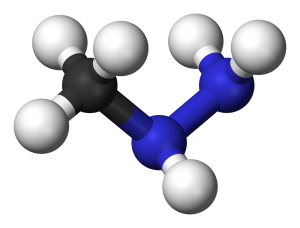
One of the molecules that pushes ATV to the Station: MMH Credits: Public Domain via Wikimedia Commons
So once at its cruising speed of 28 800 km/h (thank you, Ariane 5), an ATV needs 1170 kg of propellant, of which 441 is MMH and 729 is MON.
Considering MMH density is 0.875 kg/l, we would need 504 litres of the stuff. Using a MON density of 1.114 kg/l we would need 654 litres of MON to dock an ATV.
Combining these gives a total of 654+504=1160 litres of propellant to dock an ATV, once in orbit.
Docking generally takes five days, so during that time period an ATV will travel: 24 hours in a day X 5 days X 28 800 km/h = 3.456 million km travelled on 1160 litres of propellant which translates to a ‘fuel consumption’ of just 0.03 litres per 100 km!
Disclaimer: These calculations show fuel consumption for educative purposes and may not reflect real driving results, your mileage may vary. We did have fun working this out, keep your questions coming…

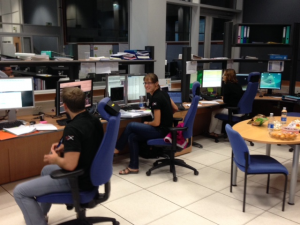
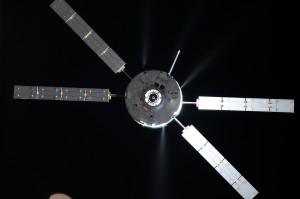
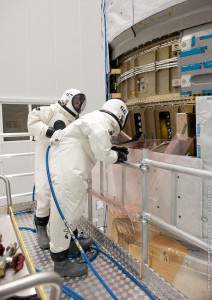
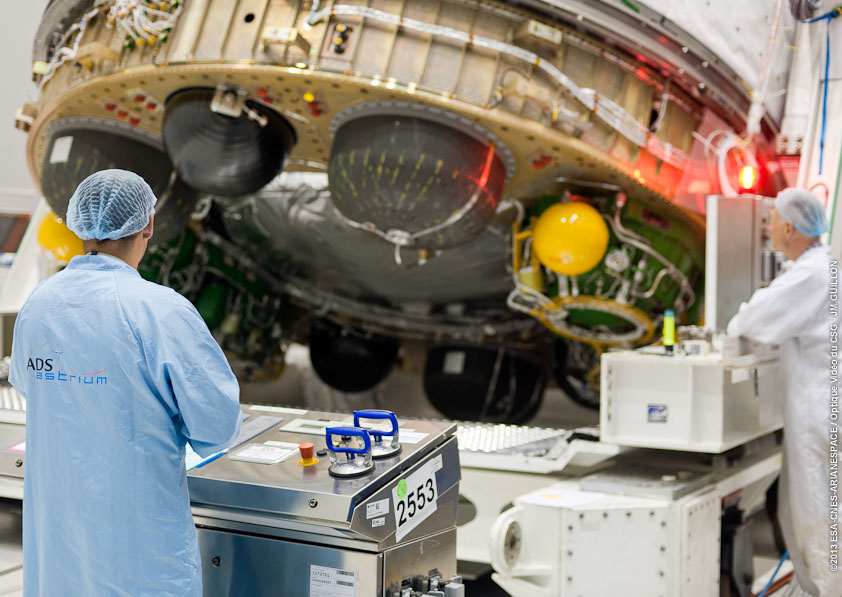
 Automated Transfer Vehicle page
Automated Transfer Vehicle page ATV blog archive
ATV blog archive
Discussion: 8 comments
Citizen correction – this article contains a major mistake, please consult your engineers again and correct it. Details below:
“a ratio of 1.65 oxidizer to fuel” – yes, this is correct, there is pretty much always more oxidizer than fuel in rocket engines
“an ATV needs 1170 kg of propellant, of which 709 is MMH and 461 is MON” – this, however, is patently wrong. It is the other way around – 461 kg of MMH (the fuel) and 709 kg of MON (the oxidizer). As I said above, there is always more oxidizer than fuel by mass in rocket engines, so the mistake is easy to notice. As a result, the rest of the calculations are wrong as well.
An excellent article. But let’s not forget that ATV also got a full autopilot! So not only it burns tiny amount of fuel, but also can fly and dock on it’s own, without any assists thanks to the LIRIS. Truly a masterpiece of engineering.
Plus: it looks like a cargo-version of the X-wing 😉
thank you, consumption 0,03 l per 100 km is very good, hats off to constructors and scientists!
Awesome article. Would love more of these more detailed answers instead of the media adjusted dumbed down versions. I think many of us wouldn’t mind more complicated answers!
You can’t tell how efficient rocket engines are that way. If the maneuver would take 10 days with the same amount of propellant used, it would only use 0.015 l/100km. Does that make sense?
Usually you compare rocket efficiency with Isp (how much the engine can change the velocity with a given propellant mass), higher Isp is better.
ISS orbits with about 27,600 km/h, the ATV started with 28,800 km/h, which leads to a dV of about 1,200 km/h or 333 m/s.
The latest ATV started with 20,2T mass and used about 1160kg of it as propellant.
So this ATV has an Isp about 574s with its propellant driven engines. The highest Isp got by chemical engines was about 470s.
The best Isp currently is claimed by ion drives with about 21.400s, which is about 37 times more efficient than the ATV engines. THAT is fuel effective.
Thank you. A nice and interesting article.
Well, actually, for all of us non-English speakers, some diagrams will have been much help. For instance…, many of us will have to look up in internet to understand what is “yaw stearing”, “slew manoeuvres”, phasing period and attitude.
After the correction of the mistake that was pointed out by the first commenter, there still seems to be one more mistake. Towards the end, the phrase
> Using a MON density of 1.114 kg/l we would
> need 1163 litres of MON to dock an ATV.
should be changed to read “Using a MON density of 1.114 kg/l we would need 636 litres of MON to dock an ATV.”
You said it right here: “So once at its cruising speed of 28 800 km/h (thank you, Ariane 5)…” That means the calculation with 0.03 litres per 100 km is just hilarious, not taking into account the tons (650+) of propellant, ariane just burnt to bring you on that speed and height.
Julien
Thank you for your great explanation, I love the way it is written.
What a fantastic engineering achievement the ATV is, especially the automatic docking.
Great job guys and girls.